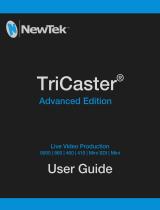
1
Using BOSS TONE STUDIO for GT-1000
Introduction
BOSS TONE STUDIO for GT-1000 (hereafter “Tone Studio”) can be used with
both the GT-1000 and GT-1000CORE.
5 In this Owner’s Manual, “GT-1000” refers to both the GT-1000 and GT-1000CORE
models.
5 The Tone Studio screens shown in this manual assume that a GT-1000 is connected.
5 The patch numbers on the GT-1000 are shown as “U01-1, U01-2...”
whereas the patch numbers on the GT-1000CORE are shown as “U001,
U002...”
Getting Ready to Use TONE STUDIO
Installing the USB Driver
Before you use TONE STUDIO, the appropriate USB driver for the product
you’re using must be installed on your computer.
1. From the product support page, download the GT-1000
Driver.
To obtain the latest USB driver, access the following URL, and
download and install the appropriate driver for the product you’re
using.
http://www.boss.info/support/
2. Double-click the downloaded GT-1000 Driver.
Installation begins.
Proceed with the installation as directed by the installation screens.
When the screen indicates “Installation has been completed.” click
the [Close] button.
The GT-1000 Driver has been installed on your computer.
* Both the GT-1000 and GT-1000CORE use the same USB driver.
Installing TONE STUDIO
MEMO
Before you install TONE STUDIO, the USB driver must be installed in your
computer as described in “Installing the USB Driver” (p. 1).
Windows Users
1. Unpack the Zip le.
2. Double-click “BOSS TONE STUDIO for GT-1000 Installer.
exe.”
Installation begins.
3. Proceed with installation as directed by the install screens.
4. When the screen indicates “Completing the BOSS TONE
STUDIO for GT-1000 Setup Wizard,” click the [Finish] button.
Mac Users
1. Unpack the Zip le.
2. Double-click “BOSS TONE STUDIO for GT-1000 Installer.
p k g.”
Installation begins.
3. Proceed with installation as directed by the install screens.
4. When the screen indicates “The installation was successful.
The software was installed.,” click the [Close] button.
Starting TONE STUDIO
1. Use a USB cable to connect the GT-1000 to your computer,
and then turn on the power of the GT-1000.
MEMO
You can edit livesets and download livesets from BOSS TONE CENTRAL
even if the GT-1000 is not connected to your computer via a USB cable.
However, you can’t save the result of editing a patch. In order to save
the edited patch, you’ll need to be connected to your computer.
2. In the [Start] menu, choose [All Programs]
&
[BOSS TONE
STUDIO for GT-1000]
&
[BOSS TONE STUDIO for GT-1000].
The rst time you start up, the dialog box “Choose a device connect
with.” appears.
MEMO
On the second and subsequent startups, the device is selected
automatically.
Mac OS users
From the Finder, in the application/BOSS/GT-1000 folder, double-
click [BOSS TONE STUDIO for GT-1000 (.app)].
3. Choose “GT-1000,” and click the [OK] button.
TONE STUDIO starts.
MEMO
Since data will be loaded from the GT-1000, it may take some time
until you can use TONE STUDIO.
NOTE
TONE STUDIO cannot be used simultaneously with the GT-1000 AIRD
Output Select Library software or the GT-1000 IR Loader software.
Close those software items before you start TONE STUDIO.
© 2020 Roland Corporation
04














